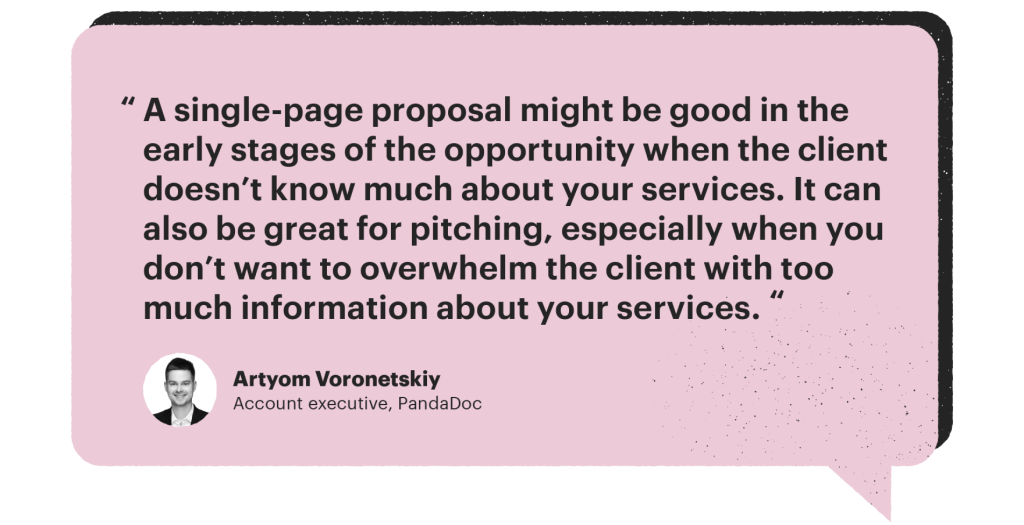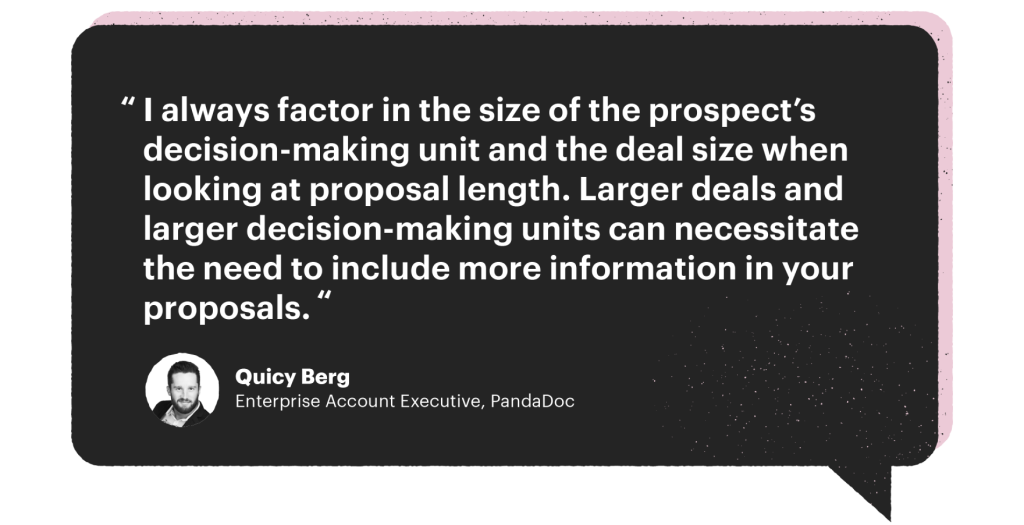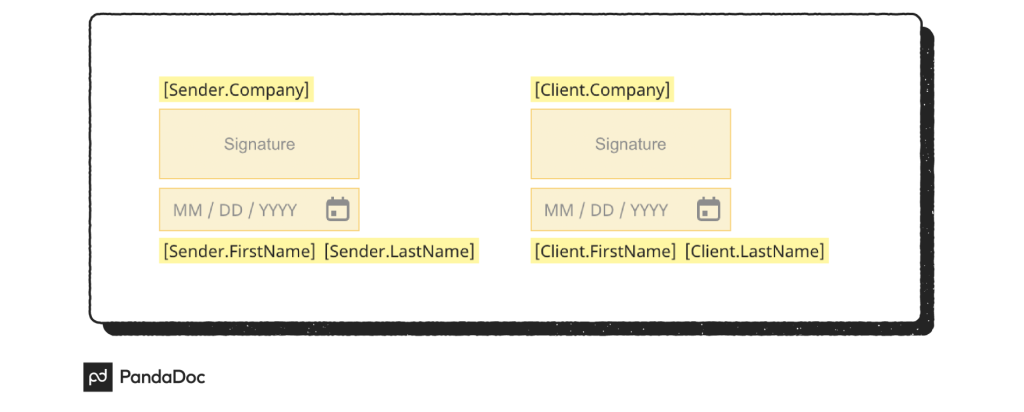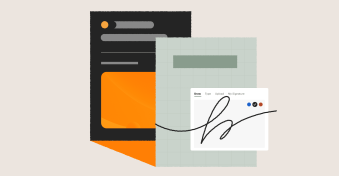No doubt about it, even under the best of circumstances, crafting the perfect one page proposal can be a major challenge for any company.
You need to include everything necessary to ensure that your potential client understands the offer you intend to make.
That will often come down to proposing exact details in a project that address pain points and provide a solution with an adequate project timeline.
Is a really possible to do that in a one-page document?
Here are some steps (and some alternatives) to creating a one-page proposal.
→DOWNLOAD NOW: FREE ONE-PAGE PROPOSAL TEMPLATE
One-page proposals vs standard business proposals
Aside from being shorter, a one-page proposal isn’t all that different from most other proposals out there. Even as a one-pager, your proposal needs to:
- Target your potential client’s problems
- Address those problems in a step-by-step manner
- Deliver timing and pricing information
- Provide points of contact and next steps
- Leave room for negotiation and feedback
And this is true for any proposal, whether you’re replying to a request for proposal (RFP) or you’re trying to formalize a back-of-the-napkin deal that you’ve been chatting about for months.
But the difference comes down to length. One-page proposals are exactly that: one page. They make have a place as a soft quote, or they may lead to more precise proposals later on.

Our own data backs that up.
Based on our own internal analysis from nearly 570k proposals on the PandaDoc platform, the average page range for a formal business proposal is usually around nine pages.
Note that you can find information and one page proposal examples from the small business administration saying that proposals should be 30 to 50 pages.
That’s true if you’re trying to create a formal business plan, but it’s not what we’re talking about here.
Instead, we’re talking about the types of proposals that you might use to win money or close deals, typically sales proposals and project proposals.
Also, due to submission guidelines, one-pagers aren’t usually a good fit for grant proposals and research proposals. It depends on the competitive process and the requirements for the grant.
But, as you’ll see below, one-pagers can still have their place in your sales operation.
Questions that any proposal should answer
Despite its shorter length, your one-page proposal (and any other proposal you write) should always answer the following questions:
- Who is it from? This is critical, especially if you’re competing against other proposals. When the recipient is ready to act, they should be able to quickly identify points of contact and best ways to get in touch.
- What is the project scope? Outline your project, new idea, marketing plan, or course of action in a clear and succinct manner with little room for error or misinterpretation. Define what actions need to take place and what resources you need in order to complete the project.
- What will you deliver? Define your solution and related deliverables, if any, and what the client should expect to receive from working with you.
- Why is your recommended solution best? Most potential customers are balancing the cost of a recommended solution with the potential benefits. Tell the recipient why your proposed course of action is necessary, and why it matters to them.
- What are the estimated timelines for the project? Include a timeline for project execution and a deadline or milestone for deliverables. In an open-ended proposal, these details may be estimates. Ongoing solutions may not have a precise deadline, but they may have a specific cutoff date.
- Where is the point of delivery? It may be concrete or abstract, physical or virtual, but you must have a final destination. Where your proposed course of action takes place is a necessary component of your one-page proposal.
Clear and concise: why (and when) to write a one-pager
The elements of a proposal range from a cover letter to testimonials, but a good one-page proposal eliminates many details.
So, why should you send one?
The case for a one-page business pitch is almost always the same: Life is short and nobody wants to wade through 50 pages of text to figure out what you’re trying to say.
Quincy Berg, Enterprise Account Executive with PandaDoc, puts it this way:

Much as they do for documents on the web, potential customers usually won’t read proposals on a word-by-word basis.
Instead, they’ll skim the contents and try to best determine whether your content fits their needs.
One-pagers drastically reduce the clutter and help your clients cut directly to the heart of the matter, which helps to ensure that the most critical information is front and center.
As a result, one-page proposals can lead to faster decision times and help you achieve greater clarity when offering solutions.
This increases the likelihood of approval and demonstrates your knowledge and expertise without any unnecessary fluff.
When done correctly, everyone wins!
One-page proposals: the downsides
Before you open your proposal writing software of choice or start measuring out the margins on a single page in Microsoft Word, take a moment to consider that creating a one-page proposal won’t be as easy as it sounds.
In general, shorter proposals give you less room to customize your content or supplement your content with social proof like case studies and testimonials.
You probably won’t be able to incorporate images or video, either — something utilized by over 80% of the proposals we analyzed.
So you’ll need to pay close attention to formatting to make the document appealing and easy to read.
Most of the time, there just isn’t room for that when you only have one page to work with (although there are some ways around this and we’ll cover them a little later).
While there is something to be said about keeping things short and sweet, it’s entirely possible to find yourself in a position where a one-page business case won’t be enough to make your proposed solution shine.
When dealing with brand new clients (who don’t know how you work), or when your proposal needs more than a single page to push it over the finish line — which is often the case — a one-page proposal may not make sense.
The packet system (a one-pager alternative)
While the idea of a one-pager sounds nice — especially if you’re trying to optimize your document workflow when sending proposals — a single-sheet document might simply be out of reach in some industries.
You may need to send attachments like Excel spreadsheets or PDF documents to provide additional details about your proposed solution. Even something as simple as a document verifying your non-profit status (if you’re a non-profit) would be enough to double the length of your proposal!
If that’s the case, don’t fear! We’ve got you covered.
A one-page approach can still work for you so long as you’re able to standardize the other documentation that you need to send.
In a scenario like this, you would create a one-page proposal and then attach all relevant or supporting documentation to it.
For example, if you felt that your one-pager needed additional social proof, create a small packet of case studies and testimonials that you can send along with your one-page proposal.
Naturally, your potential clients will review all associated documents, so they’ll be able to parse the information that’s most relevant to them quickly (plans, designs, company info, etc.) after they review your proposal.
This approach is something of a split between a one-page proposal and a standard proposal because it allows you to push all the important information to the front and send the rest in a secondary format rather than burying it inside the pages of a single, long-form document.
How to write a one-page proposal
Now that you’re familiar with everything your one-pager should contain and why you might write one, let’s take a closer look at the structure that it might follow.
Here’s a quick look at a one-page proposal outline:
1. Title
As with any document, a strong title is a must-have.
In a one-page proposal, your title doesn’t need to be cute or catchy, but it should convey accurate information about your proposal and your recommended solution.
Strong titles can be difficult to come by, so many companies use simple titles like:
“Proposal for ABC Company from XYZ Company”
Unfortunately, the downside to that approach is that your title doesn’t disclose anything about the details of your proposal.
Instead, try for more innovative titles that sum up your unique offering.
“Improving Conversion with Social Media Marketing”
“Lowering Overhead with Efficient Lighting Installations”
“Empowering Your Team with Modular Workstations”
Your proposal titles don’t have to be very long, but they should sum up your proposed solution and how it can help your potential customer achieve their goals.
Quick tips:
- If you’re struggling to come up with a good proposal title, create the rest of your proposal and circle back to this section.
- Proposal titles should be positive without overpromising. If you’re unsure of the results your solution can provide, stay clear of hard numbers and guarantees.
- Titles are a great location to target the most critical pain point that your customer highlighted in their RFP or discovery call. Review your initial contact and documentation and use the title to speak directly to that issue.
2. Executive summary and description
For your one-pager, your executive summary or description should sum up your proposal in two or three sentences.
This paragraph can be concise and to the point while encouraging readers to read the rest of the page for additional details surrounding your solution.
Traditional, long-form executive summaries that take up half a page will be far too long for this section.
However, if you’ve written proposals in the past and you’re more comfortable using a standard-length summary as a starting point, write that paragraph first and then trim it to fit.
Here’s a great example of an executive summary designed to fit a one-page proposal:
Based on our previous conversations and discovery calls, we believe that [Product 1] will be very useful to your situation and can help you reach your business goals.
This product was specifically developed to help companies in your market overcome [customer pain points].
Our onboarding process will allow you to implement this solution with ease. Our team will also work closely with you throughout this process.
Below, you’ll find a detailed project timeline, including estimated milestones, pricing, and next steps.
Ideally, the executive summary for your one-pager summarizes and provides context for everything else on the page.
This is especially important if you’re relying on pricing/product tables to keep information condensed and easy to read.
Quick tips:
- Spend time fine-tuning your Executive summary. While this section is small, it’s critical to your proposal. If your summaries and descriptions aren’t well-written, the rest of your proposal may not even be read.
- Be as clear and concise as possible when stating the potential client’s problem and your proposed solution. Refer back to previous conversations and touch on what led you to recommend this solution.
- Because one-pagers are so brief, this is one of your only chances to “sell” your solution. Don’t waste the opportunity, but remember that space comes at a premium.
→DOWNLOAD NOW: FREE ONE-PAGE PROPOSAL TEMPLATE
3. Deliverables
If your project involves deliverables, you’ll need to define them in precise terms so that potential customers understand what you’re offering and what they will receive when everything is said and done.
Whether you’re rendering services or products, it’s important to be absolutely clear about what you’re providing and what your customer can expect before, during, and after the deal is signed.
Quick tips:
- While this section is critical, there’s no reason to make it overly complicated. A small table or a single line of text describing your end product may be enough.
- For physical products, it might be best to attach a quote or an invoice that includes an itemized list of all products associated with the order.
- If you’re planning to render service over a set period of time (example: SEO services for 90 days), then you may be able to combine this with the “Timeline” section below and create a single table to show the timeline during which intended deliverables will be provided.
4. Timeline
This section can be used to communicate a timeline of service or the major milestones or benchmarks of your project.
How you choose to use it will depend on what you need to convey and what information is most relevant to the customer.
For example, if you’re delivering a physical product, this section might best be utilized for estimated shipping and delivery information.
On the other hand, if you’re building a website, you might outline milestones for different stages of project completion, including wireframing, feedback, and implementation.
However, you choose to use this section, do your best to make timeline objectives clear for the reader.
You may also find an opportunity to combine this information in your Deliverables or Pricing section, which can help you save space on the page.
Quick tips:
- Choose timeline and project/product delivery information that will be most relevant to the customer.
- For milestone projects, don’t forget to include an estimated ETA for project completion.
- If the service you provide is tied to a specific period of time, combine this section with pricing or deliverable information in order to save space when possible.
5. Pricing
One important detail that every client will want to know is how much your solution will cost them.
Pricing is one of the most prominent sections of any proposal, and it’s no different whether your document is a one-pager or a standard-length proposal document.
Display pricing prominently so that businesses can understand the costs upfront.
If your organization typically withholds pricing on its website, it’s even more important here since this may be the first contact that potential customers have had with your ticket price.
Quick tips:
- Pricing tables are a great way to indicate price while connecting those costs directly to your products or services.
- When possible, you might be able to combine this information with other sections.
6. Additional terms
Many contracts need to mention critical terms or final details that are essential for customers to understand prior to agreeing to a proposal.
This could include everything from flexible delivery dates to contingency clauses that only allow contract fulfillment under specific circumstances.
The COVID-19 pandemic is a great example of where additional clauses might come into play.
With many supply lines experiencing delays, an additional term stating that deliveries are estimates and subject to parts availability would make complete sense in this section.
Of course, you won’t have space to include an entire contract’s worth of terms and conditions.
In your one-pager, this section should only be used for terms that are most critical to the discussions at hand.
Quick tips:
- Use this section to cover terms and exclusions that are essential to the content listed in your proposal, but keep in mind that this section is limited by space to a few sentences at most.
- Have additional terms and conditions that your potential client needs to be aware of? Use this section to point to your generic terms and conditions document and attach it to your one-page proposal.
- If it’s absolutely essential that someone acknowledge these terms and conditions, consider using bold or italic font styling to highlight these clauses. If you’re using a tool like PandaDoc, you could also use the initials field from the fillable fields toolset to ensure that signers acknowledge them. Do this by placing an initials field near your additional terms and marking the field as Required, so that readers are forced to acknowledge it before completing the document.
7. Call to action
Perhaps more complicated than it sounds due to its marketing background, your call to action doesn’t have to be fancy or fluffy.
Instead, this is a single line that encourages someone to take the next step with you and gives them instructions on how to do so.
Your call to action can be as simple as inviting someone to sign your one-pager.
You could also add phrasing about calling or setting a meeting to work out additional details or answer questions if you’d rather the client get in touch with you prior to signing off.
While it’s entirely up to you, this section should always provide readers with instructions on the next steps required to move the deal forward.
Quick tips:
- Don’t be afraid to keep this section short and sweet. If you feel like you’ve submitted a decent bid and you aren’t interested in negotiating, instructing someone to sign at the bottom and send the document back to your team is probably enough to get the job done.
- It’s very easy to use this section as a kind of summary or wrap-up, but keep in mind that space is limited! A long conclusion paragraph isn’t likely to fit, so choose your approach carefully when authoring this section.
- While you can personalize this section for each customer, it’s also easy to create generic content when designing your proposal template so that this section only needs minimal maintenance. You could also use the PandaDoc content library to create several calls to action so that your sales reps can swap them in based on the nature of the proposal.
8. Contact information and signature

At the bottom of your one-pager, be sure to include contact information for your organization along with a signature field where potential customers can acknowledge and accept your proposal.
In a one-pager, both of these items are essential. The contact information listed should connect the client with their point of contact inside your organization — usually the sales representative who initially sent the proposal.
The signature field is important because it allows the reader to accept the terms of the proposal in a way that is transparent and legally binding.
With PandaDoc and other signing platforms, documents sent for signature are locked so that neither side can make changes.
While it’s possible for both sides to negotiate terms, sending proposals in this way ensures that potential customers are signing the proposal you sent without making unacknowledged changes.
It also provides some level of protection for the customer so that they know the proposal they agreed to can’t be changed later without their acknowledgment.
Quick tips:
- Space is limited on a one-page proposal, so you may only have room for one signing agent from each organization (yours and theirs). Be sure to name the individual with appropriate signing authority on your proposal.
- Contact information should include names, phone numbers (with extensions), and the email address of the individual that the client may need to reach.
Extra tips
- Before writing anything, gather or research all the necessary information required to complete your proposal.
- Tackle the easiest parts of the proposal first. For instance, if your prices are fixed, save time by adding these details to your proposal early on in the process.
- It’s possible to cram too much information into a single page. Take the time to evaluate what you need to make the best possible case in the limited space that you have.
At the end of the proposal, provide a place to sign.
This ensures both parties understand the details of your agreement.
As you build your proposal, keep in mind that a one-pager is essentially a scaled-down version of a full proposal.
Every detail you include must support your recommended solution and drive the reader to a decision point.
But, due to brevity, anything that can be reduced or that doesn’t move the reader along needs to be cut. A title page is a great example.
While it’s nice to have in a standard proposal, doubling the length of your proposal just for a title won’t make sense.
Likewise, you won’t need a table of contents (because your document is one page long), and you may need to drastically reduce other secondary elements, like testimonials, case studies, and other social proof.
One-page proposal template and example
Staring at a blank page and not sure where to start? Grab a template from our template library and import it to PandaDoc to make it yours.
For one-pagers, we offer two basic templates:
Always remember, when using one page proposal samples and templates, there’s no shame in modifying the template to suit your taste.
Free one-page business proposals templates and examples are just there to give you a starting point and some idea of how to proceed, so take out what isn’t necessary for your situation and add sections that make sense for your readers.
If responding to an RFP, make sure you answer all of the points or questions included in the request.
Writing a one page proposal all wrapped up
And that’s everything you need to know about writing a one-page proposal in a nutshell.
It’s a fact that it sounds much easier than it is, but a well-placed one-pager can catch the eye and get the job done without wasting time on long-form formats and layouts or unnecessary information.
As with most short documents, the key to writing the one-page proposal is to say as much as you can while using the smallest number of words possible.
Clear and concise; that’s the goal.
Tools like our content library and built-in editor can go a long way toward making your one-page proposal a success.
Learn how you can optimize your document workflow by scheduling a free 15-minute demo to learn more about PandaDoc — including our one-page proposal templates.
Frequently asked questions
-
Outlines can be helpful to ensure you have all the necessary information for your one-page proposal.
If you’re outlining, be sure to include each of the following:
- Executive summary or description
- Deliverables
- Timelines / deadlines
- Pricing information
- Call to action
- Contact information
- Electronic signature block
Alternatively, get started with a template and customize it to taste.
-
Use a one-page proposal when information can be easily simplified, when you want to stand out from the competition, and, of course, when requested.
If you feel you need a full proposal, you can always send a one-pager with a note that the full project proposal is on the way or you can standardize most of your proposal information and send it as supplemental attachments.
-
Identify the essential elements and remove the rest.
Remember, your proposal must answer these six questions succinctly:
- Who is the proposal from?
- What is the project scope?
- What will you deliver?
- Why is your recommended solution best?
- What are the estimated timelines for the project?
- Where is the point of delivery?
Also, look for ways to shorten sentences or communicate effectively with fewer words. If you need help, ask a colleague to look it over and make suggestions.
-
No. You don’t need a template.
However, a template can provide a basic framework for your one-page proposal so that you don’t start from a blank slate.
The beautiful thing about templates is that you can modify them for your own situation. PandaDoc has a library of 170+ business proposal templates — including proposal examples!
Pick one that you like, load it into the PandaDoc editor, and customize it to your heart’s content.
Disclaimer
PandaDoc is not a law firm, or a substitute for an attorney or law firm. This page is not intended to and does not provide legal advice. Should you have legal questions on the validity of e-signatures or digital signatures and the enforceability thereof, please consult with an attorney or law firm. Use of PandaDocs services are governed by our Terms of Use and Privacy Policy.
Originally published November 15, 2021, updated December 1, 2023



